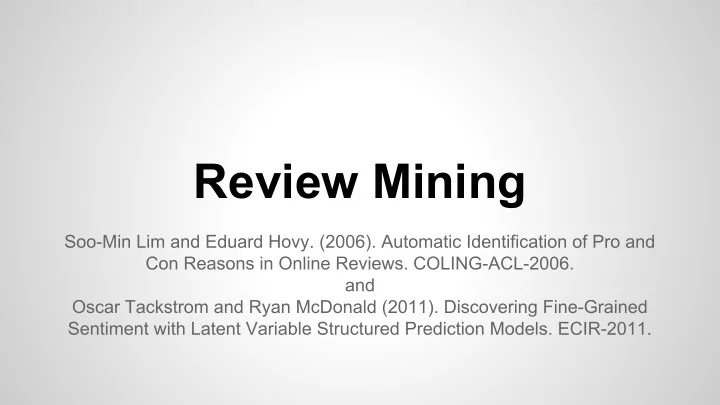

Review Mining Soo-Min Lim and Eduard Hovy. (2006). Automatic Identification of Pro and Con Reasons in Online Reviews. COLING-ACL-2006. and Oscar Tackstrom and Ryan McDonald (2011). Discovering Fine-Grained Sentiment with Latent Variable Structured Prediction Models. ECIR-2011.
Automatic Identification of Pro and Con Reasons in Online Reviews Overview ● Goal: ○ Extract sentences that explain the sentiment of reviews (pros/cons) ● Difficulties: ○ No/little labeled data ○ Pros/cons may be objective sentences ■ e.g., “the battery life lasts 3 hours” ○ Domain-specificity
Automatic Identification of Pro and Con Reasons in Online Reviews Overview ● Focus on reasons for opinions ○ reason may be objective statement ● 2 steps: ○ generate training data by aligning pros and cons with opinion- bearing sentences ○ train MaxEnt classifier to automatically identify pros and cons ● Training data: epinions.com, <review text, pros, cons> triplets ● MaxEnt classification in 2 parts: ○ identification phase ○ classification phase ■ features: lexical, positional, opinion-bearing words ● Testing data: complaints.com
Automatic Identification of Pro and Con Reasons in Online Reviews Intuitions ● MaxEnt: “best model is the one that is consistent with the set of constraints imposed by the evidence but otherwise is as uniform as possible” ● Lexical features: “there are certain words that are frequently used in pro and con sentences which are likely to represent reasons why an author writes a review” ● Positional features: “important sentences that contain topics in a text have certain positional patterns” ● Opinion-bearing word features: capture pro and con sentences which opinion-bearing expressions (objective sentences should be captured by lex and pos features)
Automatic Identification of Pro and Con Reasons in Online Reviews Discussion ● Novel part of paper is alignment step, but there is no explicit evaluation of this step ● Pro/con dictionary baseline for identification? ● Why where identification and classification separate steps? ○ Could do identification of cons, identification of pros ● Training set balanced differently than test set ○ epinions.com -- more positive reviews ○ complaints.com -- mostly negative ● “The average accuracy 68.0% is comparable with the pair-wise human agreement 82.1%” (baseline 59.9%) -- ??? ● Best accuracy and recall on restaurant complaints, best precision on mp3 complaints ● Captured both opinion-bearing and objective pro/con statements
Discovering fine-grained sentiment with latent variable structured prediction models Overview ● Fine-grained sentiment analysis, from coarse-grained supervision ● This is important because ○ Applications like opinion summarization and search we need analysis on fine-grained levels ○ Available data usually has document level labels ● Goal: Has better performance on sentence than lexicon based and document centric ML approaches
Discovering fine-grained sentiment with latent variable structured prediction models Overview ● Hidden Conditional Random Fields (HCRF) model analyzes sentence-level sentiment ● Training set: 143,580 positive, negative and neutral reviews from five different domains: books, dvds, electronics, music, and videogames ● Test set: 294 positive, negative and neutral reviews
Discovering fine-grained sentiment with latent variable structured prediction models Intuitions ● Documents may have a dominant class without having uniform sentiment. Will likely have majority one sentiment, some neutral, and minority other sentiment. ● Sequential relationship between sentence sentiment ● Document sentiment is influenced by all sentences and vice versa
Discovering fine-grained sentiment with latent variable structured prediction models Overview ● Hidden CRF model y d observable variable ● ○ for document ○ sentiment ○ y s ● i (i=1..n) latent variables for sentence ○ sentiment ○ ○ Training: HCRF is trained on document level labels ○ Decoding: Sentence level labels are obtained from latent variables
Discovering fine-grained sentiment with latent variable structured prediction models Discussion ● Sentence analysis without sentence level supervision ● Diverse set of review subjects ● Performance increase on larger data sets ● Comparison to baseline system trained on sentence- level sentiment data ● Little about choice of features ● Little about training process
Comparing Papers ● Both are similar tasks: sentence-level sentiment from document- level labels ● (Lim, Hovy) exploits structure of epinions.com ○ Better surface-level results, but more questionable methodology, evaluation ○ Straightforward ○ Task seems harder ● (Tackstrom, McDonald) uses machine learning model with latent variables ○ Doesn’t need special structure of text ○ Requires more data
Discovering fine-grained sentiment with latent variable structured prediction models Optimization We model probability of vector: y d =(y d , y s ) conditioned on input sentences: ● p θ (y d , y s | s )=exp{<φ(y d , y s , s ), θ> - A θ ( s )} ● From independence assumptions φ(y d , y s , s ) = ⊕ n i=1 φ(y d , y s i , y s i-1 , s ) φ(y d , y s i , y s i-1 , s ) =φ(y d , y s i , y s i-1 ) ⊕ φ(y s i , s ) ● Conditional probability of observable variable p θ (y d | s )=Σ ys p θ (y d , y s | s ) - marginalizing over hidden variables
Recommend
More recommend